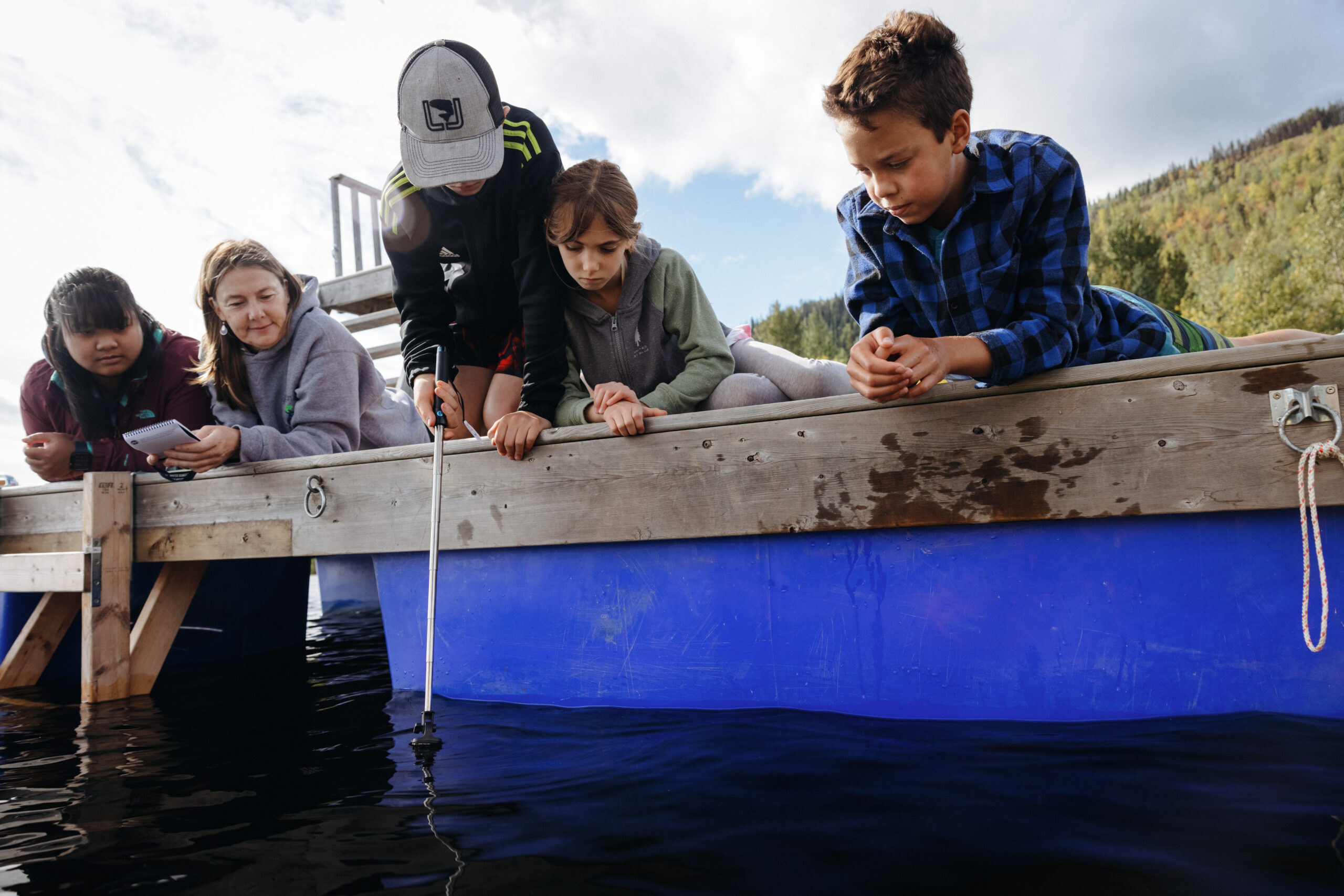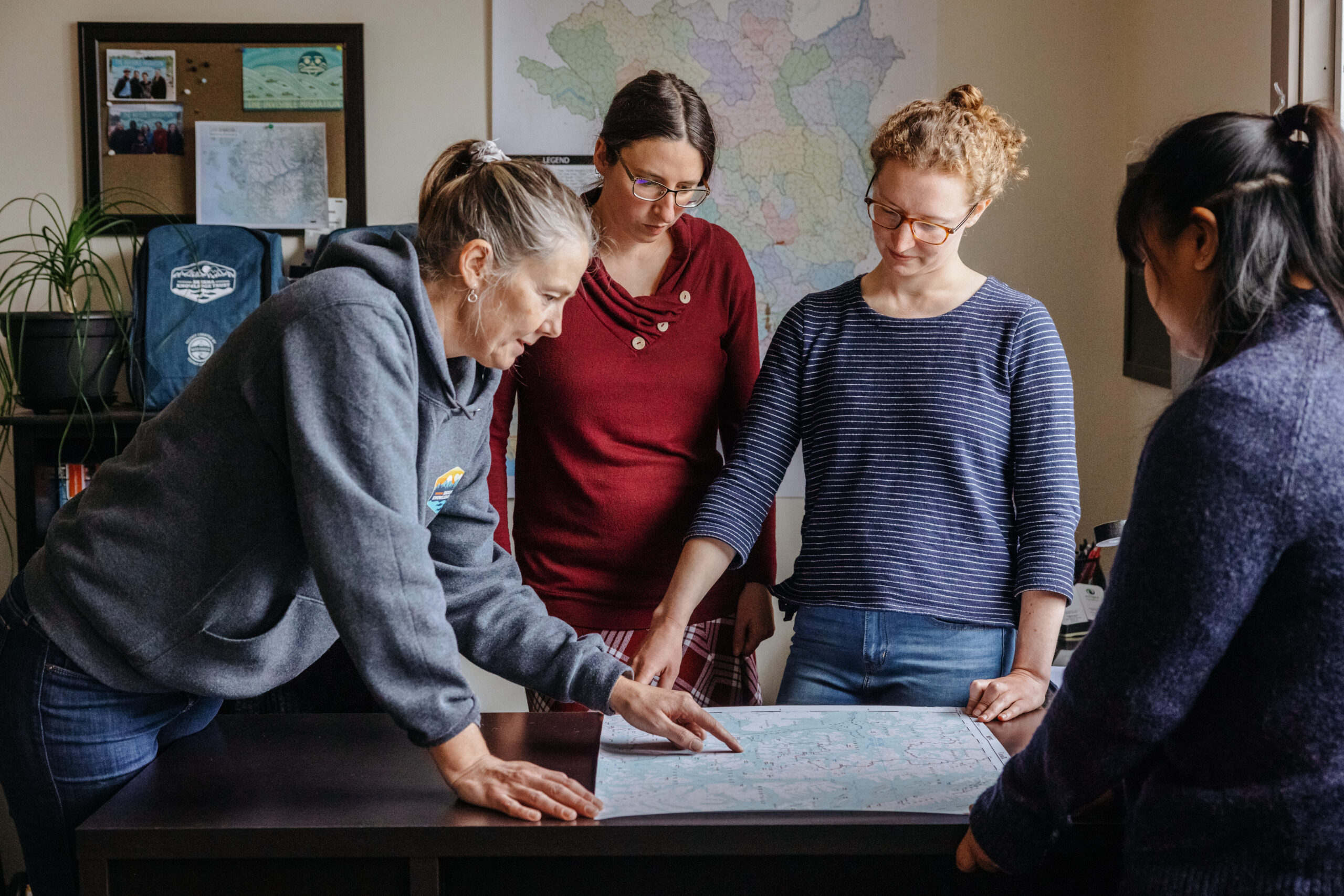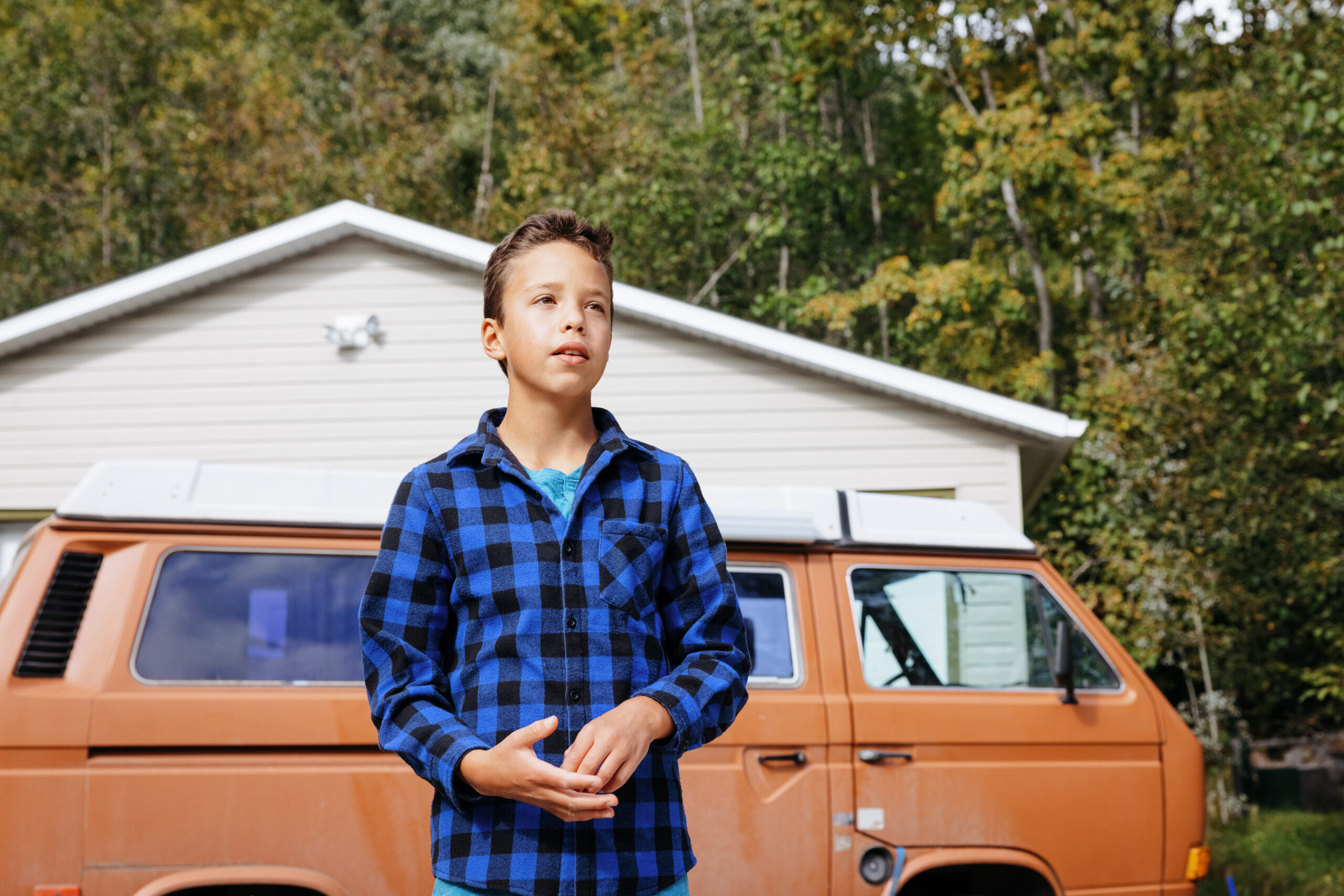
Water determines the Great Lakes Region’s economic future
Climate change, geopolitics and business opportunities power a blue economy
This story is part of When in Drought, a series about threats to B.C.’s imperilled freshwater systems and the communities working to implement solutions.
Sebastian Audet navigates his paddleboard over to a floating dock on Seymour Lake, a small freshwater body tucked into the forested hills at the base of Dzilh Yez (Hudson Bay Mountain.) A few minutes drive from Smithers, B.C., the lake is a local favourite for summer swimming and winter skating. But 12-year-old Audet isn’t here to play — he’s monitoring the health of the aquatic ecosystem.
“Dissolved oxygen is what the fish breathe,” he explains. “Right now, the dissolved oxygen is on the bottom but there’s some on the top. If it gets worse and we have a turnover, which is when it mixes it all together, we could have a fish kill and all the fish would die and float up and stuff.”
His mom, Shawna Audet, asks him how the lake’s levels are doing and he makes a face.
“Most fish can live but you couldn’t have any ‘fishing fish’ like trout because they need higher dissolved oxygen levels,” he answers.

On the dock, accompanied by his friends Kian and Kaiya Staplin, Sebastian unzips a blue waterproof case and starts unpacking various vials and test equipment. One of the threats to the lake, the Audets explain, is that many recreational users don’t clean up after their dogs while ice skating.
“Everyone wants their magical skate with their dog but as soon as their off-leash dog is behind them they can’t see what’s happening,” Shawna says.
“The magical skate people, you can’t even talk to them, they just get really mad at you,” Sebastien adds. He doesn’t know how much of a direct impact dog poop has on fish but says it’s one of several factors changing the ecosystem.
The Audet family received the free equipment — a Water Rangers water quality monitoring kit — from Skeena Knowledge Trust, a local non-profit.



“I think a lot of people just don’t understand the connection between the environment that they’re recreating in and how other people use that environment,” Johanna Pfalz, lead coordinator at the trust, tells The Narwhal.
The Skeena Knowledge Trust works with interested groups and individuals like Sebastian to provide tools, education and resources to empower people and generate much-needed data. Pfalz says when the World Wildlife Fund published its first watersheds report in 2017, it identified alarming data deficiencies in the Skeena watershed.
“This Water Rangers program was one of the responses to help to fill those data gaps,” she says. “We connect groups like this with Water Rangers and try to facilitate, to take it to that next level where kids like Sebastian actually get out there and start contributing.”

The Skeena Knowledge Trust was formed in 2017 to address data deficiencies on wild salmon and salmon habitat in the Skeena River watershed, but it had its genesis almost one decade earlier.
In early 2009, after four years of research and consultation with stakeholders across the province, a provincially appointed panel of independent scientists presented B.C. with a report on Pacific salmon that made dozens of recommendations. Among them, the panel said the province should create a new ministry to oversee information on salmon and salmon habitat.
“A new provincial governance system will require many changes, beginning with the creation of a single water and land agency responsible for making all water and land decisions in watersheds in accordance with ecosystem principles,” the report noted. “It will also require that federal, provincial, First Nations and local governments collaborate on watershed governance, and that ‘ecosystem goods and services’ such as carbon storage are valued in decisions.”
When the province hadn’t responded to the report many months later, Skeena residents convened a conference to discuss what action they could take.
“Part of what came out of that conference is that, when it comes to knowledge and information management — the information we use to make decisions around salmon ecosystems — there’s nobody managing that,” Pfalz says.



People and programs — such as Fisheries and Oceans Canada and provincial ministries — were collecting information, but there wasn’t a one-stop shop for data on salmon and salmon watersheds.
“If you have a question about the salmon ecosystem in the Skeena, you have to go to a dozen different sources,” she points out
For most people, that kind of digging (and the time required to do it) just isn’t feasible. Once the trust was formed, it developed a mapping portal and a Skeena salmon data centre, compiling all available information in one place.
Michael Price, conservation scientist and new trustee with the organization, says the data centre is indispensable for both the general public and researchers.
“One thing that the Skeena Knowledge Trust has been doing is compiling all these old fisheries reports,” he says in a phone interview. “To me, they are absolutely fascinating because they provide us with such important context for salmon.”
As an example, he points to the detailed reports written by creek walkers, the Fisheries and Oceans Canada contractors who monitor spawning salmon populations by walking the freshwater systems and counting fish. Their reports include much more than the numbers of fish returning to their natal streams.
“Some of the notes on whether there were floods or what the winter was like, they give some real context that you can potentially start to see patterns with,” he explains.
Historic reports are often difficult to find, or only available by request, but their importance cannot be understated. Conservationists relied heavily on high-quality, trusted data during the campaign to protect the Skeena estuary from the potential impacts of a proposed liquefied natural gas facility on Lelu Island, Price notes.
“What surfaced through that process — and it was quite a lengthy process — was a report that I feel was quite seminal to the argument that industrial development really needs to take care in this sensitive area.”
That report, he says, was an old Fisheries and Oceans Canada document.
“The question was posed, ‘If we have development in the Prince Rupert area, in the Skeena estuary, where are some areas that have high sensitivity to salmon?’” he explains. “They reported that they didn’t think that development should occur in the Lelu Island, Flora Bank area. So here’s a historical report that could easily have been buried, that could have been overlooked — and the whole decision could have been different.”
“It’s those types of reports — that you may not think are significant — that the Knowledge Trust is really trying to bring to the surface so that, yes, it’s easier for us as researchers or individuals that are concerned watershed citizens to find that information, instead of it being buried in some box, maybe on paper and not even digitized yet.”
“If we don’t have that information or if we forget that information, we are bound to make mistakes of the past — it’s just inevitable human nature,” he adds.
As for which reports make it into the salmon data centre, Pfalz says there are criteria to ensure credibility.
“The short of it is that basically anything that is generated through a public land-use planning process, whether it’s the Gitanyow land-use plan, or another First Nation’s land-use plan or fisheries-sensitive watershed plan, anything like that, especially the [Environmental Stewardship Initiative] work, that’s all fairly credible.”
The Environmental Stewardship Initiative is collaborative landscape-level research conducted by the B.C. government and Indigenous communities across the province. Recently, B.C. tried to argue against data collected under the program in a Supreme Court case launched by the Blueberry River First Nation. In a precedent-setting ruling, B.C. Supreme Court Justice Emily Burke dismissed the province’s arguments, included the data as evidence and found the province guilty of breaching the Nation’s Treaty Rights.
“It’s not our goal to filter information,” Pfalz says. “Maybe there’s a report that could be controversial, but it’s still very credible. It’s up to our audience to determine what they do with that information.”
On the water, Sebastian and friends note baseline data and test for conductivity, dissolved oxygen, hardness, alkalinity and more. They all agree their favourite is the test for dissolved oxygen.
“I kind of like getting to smash the vial,” Kaiya Staplin says.
“They’re clear to start with and then when you smash them it kind of immediately turns blue,” Kian Staplin adds.
Sebastian doesn’t mince words when he talks about why it’s important to collect the information.
“Because this lake’s almost at the stage of death. This lake’s going to die, like, weeds die, fish die — done.”




Ian Sharpe, a retired aquatic biologist who worked for B.C.’s Ministry of Environment for 25 years, says that’s part of the natural evolution of ecosystems.
“It will be a wetland and then it will be a meadow and then it will be a forest, with a creek running through it,” he says on a call from a Vancouver Island ferry terminal. But he adds it’s important to ensure human impacts don’t speed up the process.
Sharpe wears many hats in what he describes as “semi-retirement,” but all are connected to water and watersheds.
“I’m going to do this until I croak,” he says.
Among his multiple roles, he’s a trustee with the Morice Watershed Monitoring Trust, an organization that collaborates with the Skeena Knowledge Trust.
“Our purpose is to conserve and protect water for the benefit of Wet’suwet’en people,” Sharpe says, noting the importance of collaborating with Indigenous communities.
He describes what Sebastian and others are doing as the first step towards influencing decisions on a watershed level.
“You can start them off at the basic level and your hope is that there will be some kind of sustained effort and they will get more and more interested in getting deeper and deeper into the science,” he says. “Sometimes it works and sometimes it doesn’t — it’s a mixed bag.”


Pfalz says Sebastian’s depth of understanding of his local ecosystem sets the stage for him to interact with decision-makers.
“The more knowledgeable your public is, then that empowers the public to interact on a more knowledgeable base with the province and the feds,” she says. “It’s hard to argue with data.”
Kat Kavanagh, executive director of Water Rangers, says she’s thrilled to hear about the work Sebastian and his friends are doing. On a Zoom call with The Narwhal, her smile gets bigger and bigger as she hears about the youngster’s dedication and achievements.
“How is he doing all this stuff already?” she asks, beaming. “I love it!”
She says the idea to develop the Water Rangers kits and create the network first started when she watched her father collecting water samples, sending them away to a lab, getting the results back and having no way to make sense of it or share that data.
“Even when we were collecting data, we weren’t very effectively bringing it out into the community, bringing it to decision makers.”
After piloting the project in collaboration with the World Wildlife Fund, the demand for the test kits skyrocketed.

“The Skeena [Knowledge Trust] was one of the groups in a data deficient area that was going to be using the Water Rangers test kits,” she says. “And then we were going to give the data back to [World Wildlife Fund] in a format that they could use to help these groups start to fill those data gaps.”
Kavanagh describes herself as a tool-maker and she’s clearly passionate about the impacts the tools are having.
“Talking about climate change, people don’t know what they can do and I think that they’re looking for things that they can do to contribute,” she says. “The reason I think we’re resonating is not only is it an easy way to get eyes on the ground, we’re also a way to get that baseline data so that we can notice when things are really starting to change.”
Kavanagh says they’re working with the University of Regina on a five-year project and partnering with groups in northern Saskatchewan, where many communities don’t have the capacity to do their own water quality testing. The network extends across the entire country with different groups using the kits to address a wide range of issues.
“We had one group in New Brunswick monitoring a little river because there was a proposed mine upstream,” she says. “If the mine gets approved they have some baseline data. They can say this was the pre-state and they have some ownership of that. They said they felt helpless before and now they have a plan.”
Because data on fisheries and water quality is often hard for the general public to understand, both the Water Rangers and Skeena Knowledge Trust use charts and graphs to present the data in a more palatable format.
At an office in Smithers, Ekaterina Daviel, a technician working with the trust, shows how the Seymour Lake information is organized.
“It has a nice little timeline of all the reports that we’ve had in the salmon data centre,” she says, scrolling through the page. “It gives you a quick overview of when the reports were put together and what’s been done more recently, as well as a quick synopsis of some of the issues. We also put in a water chemistry piece and this is currently using the data from the government.”
Daviel also shows how the trust has amalgamated historic and current data from the Tyee Test Fishery, a Fisheries and Oceans Canada project that has acquired data on Skeena River sockeye populations since 1955. The interactive visualization makes it easy for users to compare historic runs to current numbers. That context is especially useful for the younger generation, which hasn’t been around long enough to witness the steady decline in salmon populations across the province.


Returning to shore, Sebastian and his friends head out to play in the woods behind the Audet’s house while Shawna inputs the data to the Water Rangers portal on an iPad. It only takes a few minutes. She demonstrates how the site charts all the data over time. On a local level, she says the work has already paid off.
“We had someone throw a whole bunch of salt in the water and I was like, ‘Wow, Johanna, our hardness just went crazy,’ ” she says.
She pulls up the graph, which clearly shows a significant spike, recalling how she had overheard a neighbour talking about throwing salt into the lake, to kill off the vegetation in the hopes of creating a sandy beach area, around the same time the spike popped up on the charts.
“It led Sebastian to go and have a conversation with the neighbour. It’s awkward but really valuable that you can speak up about what’s going on.”
Pfalz says one of the next steps is advocating for data collected by people like Sebastian for use in policy-making.
“There needs to be some more connectedness around integrating citizen science into provincial level decision-making,” she says. “The government needs data, right? That’s how they work — everything has to be documented.”
Sharpe points out decisions can also be made on a smaller scale.
“As a scientist, I connect what you need to learn with what decisions you might wish to influence,” he says. “So that’s what kind of data are you going to need, how are you going to use it [and] how are you going to interpret the information?”
For Sebastian and his friends, the water testing is a bit of a means to an end — a chance to hang out and play — but it’s also sowing a seed of awareness and creating a connection to an ecosystem that is going to need their help.
As Kavanagh puts it, one of the most important objectives is to get people out into their watersheds.
“People protect what they love. The more often you go out to the water, the more connected you are to it, the more likely you are to feel like you can do things, you can speak up for it, you can become an advocate.”
The Narwhal’s When in Drought series is funded by the Real Estate Foundation of BC, which administers the Healthy Watersheds Initiative, and the BC Freshwater Legacy Initiative, a project of the MakeWay Foundation. As per The Narwhal’s editorial independence policy, no foundation or outside organization has editorial input into our stories.
Get the inside scoop on The Narwhal’s environment and climate reporting by signing up for our free newsletter. On a warm September evening nearly 15...
Continue reading
Climate change, geopolitics and business opportunities power a blue economy

10 billion litres of sewage are dumped into Winnipeg’s lakes and rivers each year. Some...

Court sides with Xatśūll First Nation, temporarily halting Mount Polley mine waste expansion
